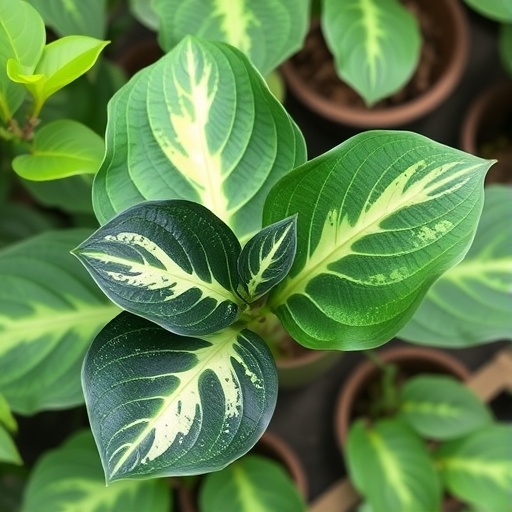In the ever-evolving field of environmental chemistry, the need for innovative and efficient solutions to tackle pollution has never been more pressing. As various pollutants continue to infiltrate ecosystems, the quest for sustainable materials capable of mitigating heavy metal contamination has gained momentum. Recent research unveiled the sophisticated utilization of phytomass-derived activated carbon from Alocasia odora, heralding a significant breakthrough in the development of electrochemical sensors for detecting lead ions (Pb²⁺) in various environments.
Activated carbon has emerged as a prominent material in environmental applications due to its remarkable adsorption properties, extensive surface area, and electrical conductivity. The activation process, wherein raw biomass is treated to enhance its porous structure, renders activated carbon an excellent candidate for sensor fabrication. This approach not only offers an eco-friendly alternative to conventional materials but also promotes waste reduction by utilizing plant biomass.
In the study spearheaded by Chinnamayan, Periyasamy, and Palanichamy, the researchers focused on transforming the leaves of Alocasia odora, commonly known for its ornamental value, into activated carbon. This method reflects a progressive shift towards sustainable practices in material science, emphasizing the potential of utilizing abundant plant resources. The transformation process involved pyrolyzing the biomass at specific temperatures to maximize the surface area and improve porosity, creating an ideal medium for capturing ions.
Electrochemical sensors rely on the interaction between the electrode material and the target ions to produce reliable measurements. The modifications made to the activated carbon through various chemical treatments further enhance the sensor’s sensitivity and selectivity toward lead ions. The researchers demonstrated that by optimizing these parameters, the activated carbon-modified electrode exhibited exceptional performance in detecting low concentrations of Pb²⁺ ions.
One of the crucial aspects of this research lies in the meticulous design of the sensor. The innovative electrode not only displayed high sensitivity but also showed excellent stability over extended periods, making it suitable for real-time applications. The researchers conducted a series of electrochemical experiments, including cyclic voltammetry and differential pulse voltammetry, showcasing the sensor’s ability to distinguish lead ions from other competing species in complex matrices, a common challenge in environmental analyses.
Moreover, the study detailed the sensor’s advantageous characteristics in terms of detection limits, with the ability to identify lead ions in the nanomolar range. This level of sensitivity is pivotal for environmental monitoring, particularly in regions with chronic heavy metal pollution. With environmental regulations tightening worldwide, the demand for reliable detection methods has surged, positioning this research at the forefront of technological advancements in pollution control.
The implications of this research extend beyond mere scientific curiosity; they highlight the urgent need for actionable solutions to safeguard public health and the environment. Lead contamination remains a critical issue, especially in areas subjected to industrial activities, improper waste disposal, and urban runoff. The development of an effective and sustainable sensor capable of monitoring Pb²⁺ levels in real-time could revolutionize existing practices and facilitate prompt interventions to mitigate pollution.
Incorporating the principles of green chemistry, the fabrication of activated carbon from Alocasia odora represents a paradigm shift, reinforcing the potential of bio-derived materials in tackling environmental challenges. This research aligns with the broader movement towards sustainability, where the focus is no longer solely on technological advancements but also on the environmental impact of such innovations. Utilizing plant biomass not only reduces reliance on non-renewable resources but also incentivizes agricultural practices, thus creating a synergistic relationship between science and sustainable development.
Furthermore, this phytomass-derived sensor fosters a deeper understanding of the interactions between plant-based materials and heavy metal ions, opening avenues for future research exploring other applications of activated carbon from diverse sources. The insights gleaned from this study could inspire further exploration into the realm of biomaterials and their potential in various environmental applications, effective not only against lead but other heavy metals as well.
As the world grapples with pressing environmental issues, studies like these stand as a testament to human ingenuity, blending ecological consciousness with cutting-edge science. The electrochemical sensor developed from Alocasia odora is not merely a technological advancement; it encapsulates a holistic approach to addressing pollution while promoting sustainability. As environmental scientists and chemists converge on this frontier, the promise of biosensors continues to illuminate pathways toward a cleaner and brighter future.
Ultimately, the research not only contributes to the scientific community’s understanding of electrochemical sensors but also ignites conversations around sustainable practices in material science and environmental monitoring. As more studies emerge, the hope is that such innovations can pave the way for a future where technology and ecology coexist harmoniously, protecting both human health and the natural world.
In conclusion, the exploration of Alocasia odora as a source for activated carbon marks a significant stride in environmental management practices. By bridging the gap between science and sustainability, this research offers invaluable insights into the feasibility of utilizing natural resources to address heavy metal ion detection challenges, heralding a new era in environmental monitoring technologies.
Subject of Research: Phytomass-derived activated carbon-modified electrodes for Pb²⁺ ion sensing
Article Title: Phytomass-derived activated carbon-modified electrode from Alocasia odora and its prospects as Pb²⁺ ion sensor: an electrochemical in sight
Article References:
Chinnamayan, S., Periyasamy, A., Palanichamy, K. et al. Phytomass-derived activated carbon-modified electrode from Alocasia odora and its prospects as Pb2+ ion sensor: an electrochemical in sight.
Ionics (2025). https://doi.org/10.1007/s11581-025-06636-z
Image Credits: AI Generated
DOI: https://doi.org/10.1007/s11581-025-06636-z
Keywords: Activated carbon, electrochemical sensor, environmental pollution, Alocasia odora, Pb²⁺ ion detection, green chemistry, phytomass utilization, biosensors.




